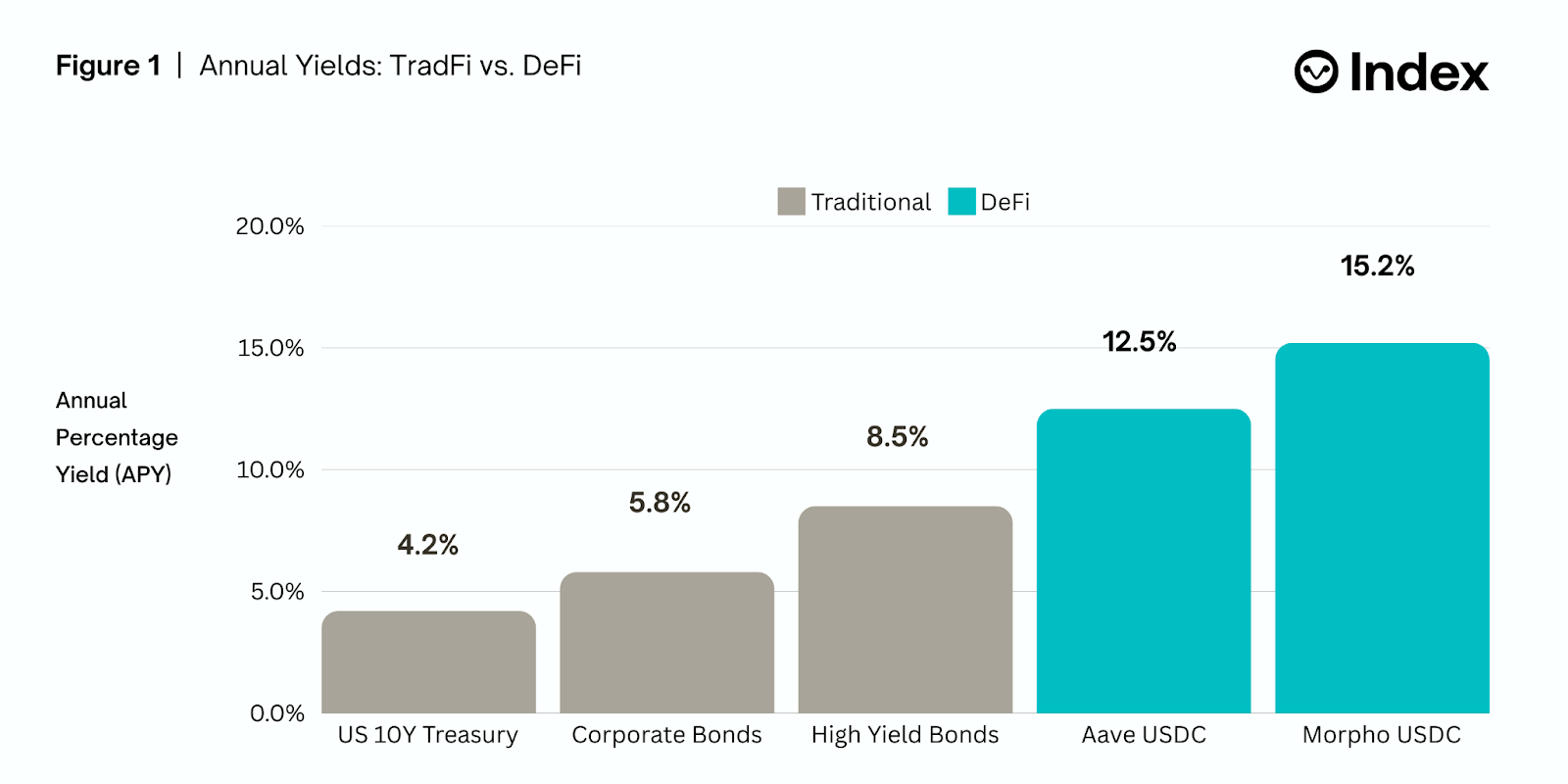Uncategorized
Stablecoin Revolution: Challenging Risk-Free Rates With On-Chain Money Markets

In traditional finance, the «risk-free rate,” the interest rate an investor can expect to earn on an investment that carries zero risk, serves as a fundamental benchmark for all investment decisions. Today, DeFi has quietly established its own equivalent: the base rate for lending stablecoins. Through battle-tested protocols like Morpho and Aave, lenders can now access double-digit yields that substantially outperform traditional fixed-income instruments, all while maintaining remarkable transparency and efficiency.
The emergence of this new base rate isn’t just a passing trend — it’s a structural shift that challenges traditional finance by demonstrating the market-driven sustainability of high-yield, low-risk on-chain money markets. At times, yields on major platforms like Morpho have reached 12-15% APY for USDC lending, significantly outpacing the 4-5% offered by U.S. Treasuries. This premium exists not from excess risk-taking or complex financial engineering, but from genuine market demand for stablecoin borrowing.
You’re reading Crypto Long & Short, our weekly newsletter featuring insights, news and analysis for the professional investor. Sign up here to get it in your inbox every Wednesday.
Market dynamics driving yields
The rise of high-yield farming strategies, especially those involving Ethena’s synthetic dollar (sUSDe) product, has been a key driver behind elevated stablecoin lending rates. Over the past year, Ethena’s USDe and staked USDe (sUSDe) have delivered yields in the 20-30% APY range, fueling substantial demand for stablecoin borrowing. This demand comes from leveraged traders aiming to capture the spread created by these high yields.
What sets Ethena apart is its ability to capture funding fees traditionally claimed by centralized exchanges. By offering sUSDe, Ethena allows DeFi participants to tap into profits generated from traders paying high funding rates to go long on major assets like ETH, BTC and SOL. This process democratizes access to these profits, enabling DeFi participants to benefit simply by holding sUSDe.
The increasing demand for sUSDe drives more capital into the stablecoin economy, which, in turn, raises the base yield rates on platforms like Aave and Morpho. This dynamic not only benefits lenders but also strengthens the broader DeFi ecosystem by increasing yield and liquidity in the stablecoin lending market.
Risk-adjusted returns in perspective
While double-digit yields might raise eyebrows, the risk profile of these lending opportunities has matured significantly. Leading money market protocols have demonstrated resilience through multiple market cycles, with robust liquidation mechanisms and time-tested smart contracts. The primary risks — smart contract vulnerability and stablecoin depegging — are well understood and can be managed through portfolio diversification across protocols and stablecoin types.

Annual Yield Comparison — Traditional Fixed Income vs. DeFi Lending Returns
30-day average as of February 1, 2025
Source: Traditional markets data from Bloomberg Terminal, DeFi markets data from vaults.fyi
Implications for traditional finance
For wealth managers and financial advisors, these developments present both an opportunity and a challenge. The ability to access stable, transparent yields that significantly outperform traditional fixed-income products demands attention. As the infrastructure for institutional participation in DeFi continues to improve, these yields may become increasingly relevant for income-focused portfolios. While yields are highly responsive to market cycles, especially funding rate dynamics, fluctuations are still common. However, the efficiency and transparency of on-chain money markets suggest that meaningful yield premiums over traditional alternatives could be sustainable in the long term.
As DeFi infrastructure matures, these on-chain money markets may not only serve as a viable alternative to fixed-income products — they could become the new standard for transparent, risk-adjusted yields in the digital economy, leaving traditional finance to play catch-up.
Uncategorized
Bitcoin Mining Profitability Fell in August, Jefferies Says

Bitcoin (BTC) mining profitability declined 5% last month primarily becuase of an increase in the network hashrate, investment bank Jefferies said in a research report Sunday.
«A hypothetical one EH/s fleet of BTC miners would have generated ~$55k/day in revenue during August, vs ~$58k/day in July and ~$44k a year ago,» wrote analysts led by Jonathan Petersen.
The hashrate refers to the total combined computational power used to mine and process transactions on a proof-of-work blockchain, and is a proxy for competition in the industry and mining difficulty. It is measured in exahashes per second (EH/s).
U.S.-listed mining companies mined 3,573 bitcoin in August versus 3,598 in July, the report noted, and these miners accounted for 26% of the Bitcoin network last month, unchanged from July.
MARA Holdings (MARA) mined the most bitcoin of the group, with 705,703 tokens, followed by IREN (IREN), Jefferies said.
MARA’s energized hashrate is still the largest of the group, at 59.4 EH/s, with CleanSpark (CLSK) second with 50 EH/s, the report added.
Read more: Bitcoin Network Hashrate Returned to All-Time Highs in August: JPMorgan
Uncategorized
France, Austria and Italy Urge Stronger EU Oversight of Crypto Markets Under MiCA

Market watchdogs in France, Austria and Italy want the European Union to tighten its approach to crypto regulation, warning that uneven enforcement of the bloc’s landmark MiCA legislation could leave investors exposed to risks that aren’t covered by the rules.
In a joint statement, France’s Autorité des Marchés Financiers (AMF), Austria’s Finanzmarktaufsichtsbehörde (FMA) and Italy’s Consob said the first months of MiCA’s rollout revealed “major differences” in how national supervisors apply the law. Without changes, they argued, firms may shop around for lenient jurisdictions, undermining both investor protection and Europe’s competitiveness in digital assets.
The regulators set out four proposals. Chief among them is handing direct supervision of the largest crypto-asset service providers to the European Securities and Markets Authority (ESMA). They also want to close loopholes allowing EU intermediaries to route orders to offshore platforms not bound by MiCA, a practice that leaves investors without regulatory safeguards.
The authorities also called for mandatory, independent cybersecurity audits before firms receive or renew MiCA licenses, citing the sector’s high exposure to hacks. Finally, they proposed a centralized filing system for token white papers to simplify cross-border offerings and ensure legal clarity.
While MiCA was designed to harmonize crypto oversight across the EU, the three regulators say swift adjustments are needed to align with international standards set by the Financial Stability Board and IOSCO. Without them, they caution, national regulators may be forced into emergency measures that risk fracturing Europe’s digital asset market.
Uncategorized
PayPal Adding Crypto to Peer-to-Peer Payments, Allowing Direct Transfer of BTC, ETH, Others

Payments firm PayPal (PYPL) said it is expanding its peer-to-peer service by adding cryptocurrency transfers to its payment flow, the company announced on Monday.
Users in the U.S. will soon be able to send bitcoin (BTC), ether (ETH), PayPal’s dollar stablecoin PYUSD and other digital assets across PayPal, Venmo and an increasing number of crypto-compatible wallets worldwide, the firm said in a Monday press release.
The integration arrives alongside «PayPal links,» a new tool that lets users generate a one-time personalized link to send or request money. The links can be dropped into text messages, chats or email, embedding payments into everyday conversations.
Personal transfers between friends and family will remain exempt from IRS 1099-K tax reporting requirements, meaning gifts, reimbursements and shared expenses won’t generate tax forms even if crypto is involved in the transaction, the firm said.
The company said the move builds on «PayPal World,» its new interoperability initiative aimed at connecting the largest digital wallets and payment systems. Peer-to-peer payments are a key growth driver, with consumer payment volume climbing 10% in the second quarter year-over-year. In July, the firm said to expand crypto payments for U.S. merchants as part of its deeper push into global digital currency payments.
Read more: PayPal Expands Crypto Payments for U.S. Merchants to Cut Cross-Border Fees
-

 Business11 месяцев ago
Business11 месяцев ago3 Ways to make your business presentation more relatable
-

 Fashion11 месяцев ago
Fashion11 месяцев agoAccording to Dior Couture, this taboo fashion accessory is back
-

 Entertainment11 месяцев ago
Entertainment11 месяцев ago10 Artists who retired from music and made a comeback
-

 Entertainment11 месяцев ago
Entertainment11 месяцев ago\’Better Call Saul\’ has been renewed for a fourth season
-

 Entertainment11 месяцев ago
Entertainment11 месяцев agoNew Season 8 Walking Dead trailer flashes forward in time
-

 Business11 месяцев ago
Business11 месяцев ago15 Habits that could be hurting your business relationships
-

 Entertainment11 месяцев ago
Entertainment11 месяцев agoMeet Superman\’s grandfather in new trailer for Krypton
-

 Entertainment11 месяцев ago
Entertainment11 месяцев agoDisney\’s live-action Aladdin finally finds its stars





